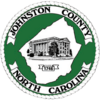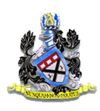Johnston County, North Carolina facts for kids
Quick facts for kids
Johnston County
|
|||||
|---|---|---|---|---|---|
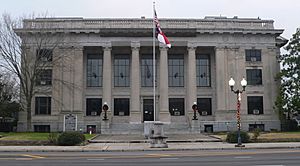
Johnston County Courthouse
|
|||||
|
|||||
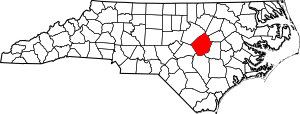
Location within the U.S. state of North Carolina
|
|||||
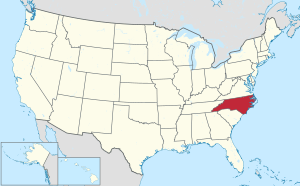 North Carolina's location within the U.S. |
|||||
| Country | |||||
| State | |||||
| Established | June 28, 1746 | ||||
| Named for | Gabriel Johnston | ||||
| Seat | Smithfield | ||||
| Largest community | Clayton | ||||
| Area | |||||
| • Total | 795.65 sq mi (2,060.7 km2) | ||||
| • Land | 792.02 sq mi (2,051.3 km2) | ||||
| • Water | 3.63 sq mi (9.4 km2) 0.46% | ||||
| Population
(2020)
|
|||||
| • Total | 215,999 | ||||
| • Estimate
(2023)
|
241,955 | ||||
| • Density | 272.72/sq mi (105.30/km2) | ||||
| Time zone | UTC−5 (Eastern) | ||||
| • Summer (DST) | UTC−4 (EDT) | ||||
| ZIP Codes |
27501, 27504, 27520, 27524, 27527, 27529, 27542, 27555, 27557, 27568, 27569, 27576, 27577, 27591, 27592, 27597, 27603, 28334, 28366
|
||||
| Area code | 919, 984 | ||||
| Congressional district | 13th | ||||
Johnston County is a county located in the U.S. state of North Carolina. As of the 2020 census, the population was 215,999. Its county seat is Smithfield.
Johnston County is included in the Raleigh-Cary, NC Metropolitan Statistical Area, which is also included in the Raleigh-Durham-Cary, NC Combined Statistical Area, which had an estimated population of 2,368,947 in 2023.
History
Johnston County and St. Patrick's Parish were established on June 28, 1746, from the upper part of Craven County. On March 1, 1752, part of Granville, Johnston, and Bladen counties were combined to form Orange County and St. Matthew's Parish. On November 23, 1758, Johnston County was divided between the Parish of St. Patrick and the Parish of St. Stephen, St. Patrick's Parish becoming Dobbs County. On December 5, 1770, parts of Johnston, Cumberland, and Orange counties were combined to form Wake County and St. Margaret's Parish. Finally, on February 13, 1855, parts of Edgecombe, Nash, Johnston, and Wayne counties were combined to form Wilson County.
Most early growers in Johnston County were subsistence farmers. A few grew tobacco as a cash crop or reared pigs and cattle, which were sold in Virginia. Smithfield was the westernmost freight port on the Neuse River, and in 1770 the colonial government erected a tobacco warehouse there to store the crop before it was shipped out. Eli Whitney's cotton gin was introduced in the county in about 1804, leading cotton to become the area's leading cash crop. Production for sale at markets remained low before the 1850s due to poor transportation links with other parts of the state. In 1856 the North Carolina Railroad was completed, connecting Johnston County with major urban areas. As result, farming for sale increased, lumber and turpentine industries developed, and the towns of Princeton, Pine Level, Selma, and Clayton were eventually created. About 1,500 Johnstonian men fought in the American Civil War, of whom about a third died. Lingering political tensions and the emancipation of slaves created social and economic turmoil. The new state constitution of 1868 created the county's first townships, which were altered up until 1913. In 1886 the "Short-Cut" line of the Wilmington and Weldon Railroad was laid through Johnston, eventually giving rise to the towns of Kenly, Micro, Four Oaks, and Benson.
The Panic of 1893 caused cotton prices to sharply decline, leading area farmers to switch to bright leaf tobacco as their primary cash crop. A new tobacco market was established in Smithfield in 1898, and the county's first bank was created. Within several years, cotton mills were erected in Smithfield, Clayton, and Selma. During World War I, a brief surge in tobacco and cotton prices brought a boom to the local economy. As a result, the county embarked on a school-construction campaign and consolidated all public schools under a single county system. In the 1920s the state built the county's first two paved highways, and shortly thereafter many towns began paving their main streets. While local commerce enjoyed significant success during the decade, area farmers struggled due to drops in tobacco and cotton prices. The Wall Street Crash of 1929 and ensuing Great Depression caused all banks in the county close. Following the passage of a state bond issue in 1949, most roads in the county and town streets were paved.
Etymology
Johnston County was named after Governor Gabriel Johnston by an act of the General Assembly during the creation of the county in 1746.
Geography
According to the U.S. Census Bureau, the county has a total area of 795.65 square miles (2,060.7 km2), of which 792.02 square miles (2,051.3 km2) is land and 3.63 square miles (9.4 km2) (0.46%) is water.
State and local protected areas
- Bentonville Battlefield State Historic Site
- Clemmons Educational State Forest (part)
- Flower Hill Nature Preserve (part)
- Howell Woods Environmental Learning Center
- Wild Bills Western Town - Shadowhawk
Major water bodies
- Black Creek
- Buckhorn Reservoir
- Buffalo Creek
- Hannahs Creek
- Holts Lake
- Little Creek
- Little River
- Middle Creek
- Mingo Swamp
- Mill Creek
- Moccasin Creek
- Neuse River
- Sassarixa Swamp
- Snipers Creek
- Swift Creek
Adjacent counties
- Wake County – northwest
- Franklin County – north
- Nash County – northeast
- Wilson County – east
- Wayne County – southeast
- Sampson County – south
- Harnett County – southwest
Major highways
 I-40
I-40


 I-42 / Future I-42
I-42 / Future I-42 I-95
I-95


 I-540 / NC 540 Toll
I-540 / NC 540 Toll


 Future I-587
Future I-587 US 70
US 70
 US 70 Alt.
US 70 Alt.
 US 70 Bus.
US 70 Bus. US 264
US 264


 US 264 Alt.
US 264 Alt. US 301
US 301 US 701
US 701 NC 27
NC 27 NC 39
NC 39 NC 42
NC 42 NC 50
NC 50 NC 55
NC 55 NC 96
NC 96 NC 210
NC 210 NC 222
NC 222 NC 231
NC 231 NC 242
NC 242
Major infrastructure
- Johnston Regional Airport
- Selma Union Depot
Demographics
| Historical population | |||
|---|---|---|---|
| Census | Pop. | %± | |
| 1790 | 5,691 | — | |
| 1800 | 6,301 | 10.7% | |
| 1810 | 6,867 | 9.0% | |
| 1820 | 9,607 | 39.9% | |
| 1830 | 10,938 | 13.9% | |
| 1840 | 10,599 | −3.1% | |
| 1850 | 13,726 | 29.5% | |
| 1860 | 15,656 | 14.1% | |
| 1870 | 16,897 | 7.9% | |
| 1880 | 23,461 | 38.8% | |
| 1890 | 27,239 | 16.1% | |
| 1900 | 32,250 | 18.4% | |
| 1910 | 41,401 | 28.4% | |
| 1920 | 48,998 | 18.3% | |
| 1930 | 57,621 | 17.6% | |
| 1940 | 63,798 | 10.7% | |
| 1950 | 65,906 | 3.3% | |
| 1960 | 62,936 | −4.5% | |
| 1970 | 61,737 | −1.9% | |
| 1980 | 70,599 | 14.4% | |
| 1990 | 81,306 | 15.2% | |
| 2000 | 121,965 | 50.0% | |
| 2010 | 168,878 | 38.5% | |
| 2020 | 215,999 | 27.9% | |
| 2023 (est.) | 241,955 | 43.3% | |
| U.S. Decennial Census 1790–1960 1900–1990 1990–2000 2010 2020 |
|||
2020 census
| Race | Number | Percentage |
|---|---|---|
| White (non-Hispanic) | 136,464 | 63.18% |
| Black or African American (non-Hispanic) | 33,041 | 15.3% |
| Native American | 880 | 0.41% |
| Asian | 1,831 | 0.85% |
| Pacific Islander | 71 | 0.03% |
| Other/Mixed | 9,312 | 4.31% |
| Hispanic or Latino | 34,400 | 15.93% |
As of the 2020 census, there were 215,999 people, 73,567 households, and 53,743 families residing in the county.
Education
Higher education
Johnston County is home to Johnston Community College (JCC), a public, two-year, post-secondary college located in Smithfield. The college has off-campus centers throughout Johnston County.
Primary and secondary education
Public K-12 education in all of Johnston County is managed by the Johnston County School District, which has 46 schools and has more than 35,400 students. In addition, three charter schools and five private schools are located in the county.
Libraries
The Johnston County Public Affiliated Library system operates six branches throughout the county. The library system keeps books, periodicals and audio books and has recently expanded the selection to include downloadable e-books. The Hocutt-Ellington Memorial Library in Clayton left the Johnston County affiliated library system in 2015.
Culture
The Bentonville Battlefield State Historic Site is the largest Civil War battlefield in North Carolina. The Battle of Bentonville was fought in 1865, and was the only Confederate offensive targeted to stop General Sherman's march through the South.
The Tobacco Farm Life Museum in Kenly has been collecting artifacts and showcasing the heritage of the Eastern North Carolina farmer for over 35 years. The site includes a museum and restored farmstead, blacksmith shop, and one-room school house.
The Ava Gardner Museum, located in Smithfield, contains a collection of artifacts such as scripts, movie posters, costumes and personal belongings of actress Ava Gardner, who was born and raised in Johnston County. The museum holds an annual festival.
The Johnston County Heritage Centers in Smithfield contains county artifacts and genealogical records.
The Johnston County Arts Council promotes arts in the county and its schools. Smithfield is the location of an annual Ava Gardner Festival, which celebrates the life of the actress.
The Meadow community is the location of Meadow Lights, an annual display of Christmas lights.
Media
Radio and Television
Johnston County is located in the Raleigh-Durham radio market, ranked by Nielsen as the 37th largest in the United States. Johnston County's first radio station, WMPM, 1270 AM, in Smithfield, signed on in 1950. The county is also home to WPYB, 1130 AM in Benson, WHPY, 1590 AM in Clayton, WTSB, 1090 AM in Selma, and WKJO, 102.3 FM in Smithfield.
The county is also part of the larger, 23-county Raleigh-Durham-Fayetteville Designated Market Area—the nation's 24th-largest. WNGT-CD, (virtual channel 34.1) a Class A low-powered TV station licensed to both Smithfield and Selma. The station began frequency sharing with Raleigh's WRAL-TV in November 2020, greatly expanding its coverage. Goldsboro-licensed CBS affiliate WNCN, virtual channel 17/RF channel 8, originally known as WYED-TV, signed on from studios and a transmitter in Clayton in 1988 before moving to Raleigh studios in 1995.
Newspapers
- Clayton News-Star
- Kenly News
- Four Oaks-Benson News in Review
- Princeton News Leader
- The Selma News
- Pine Level News
- Johnstonian News
- The Daily Record
- The Smithfield Herald
- The Cleveland Post
- The Garner-Cleveland Record
- The News & Observer
Communities
Towns
- Archer Lodge
- Benson
- Clayton (largest community)
- Four Oaks
- Kenly
- Micro
- Pine Level
- Princeton
- Selma
- Smithfield (county seat)
- Wilson's Mills
Townships
- Banner
- Bentonville
- Beulah
- Boon Hill
- Brogden
- Clayton
- Cleveland
- Elevation
- Ingrams
- Meadow
- Micro
- O'Neals
- Pine Level
- Pleasant Grove
- Selma
- Smithfield
- Wilders
- Wilson Mills
Unincorporated communities
- Allens Crossroads
- Bagley
- Blackmans Crossroads
- Cleveland
- Emit
- Flowers
- Grabtown
- Hocutts Crossroads
- Jordan
- McGee's Crossroads
- Peacocks Crossroads
- Powhatan
- Spilona
- Stancils Chapel
- West Smithfield
- Willow Spring (part)
See also
 In Spanish: Condado de Johnston (Carolina del Norte) para niños
In Spanish: Condado de Johnston (Carolina del Norte) para niños



